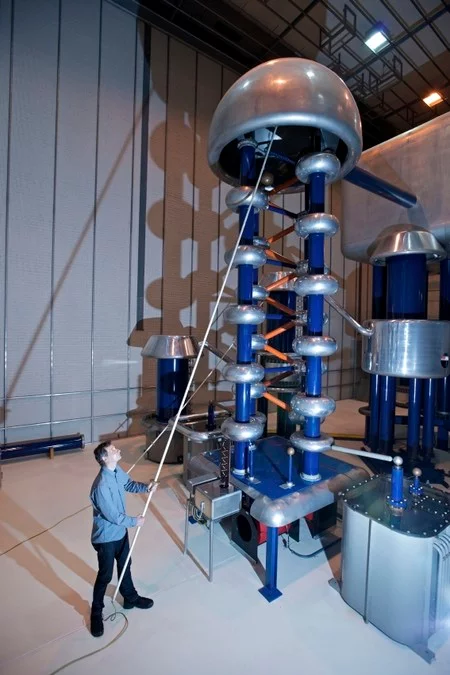The Cockcroft-Walton (CW) pre-accelerator is the first stage of the High Intensity Proton Accelerator (HIPA) Facility. It provides a continuous proton beam for the second accelerator of the facility, the Injector 2 cyclotron. The CW accelerates the protons coming from the ion source with a kinetic energy of 60 keV to 870 keV. The velocity of the protons after the CW is 13'000 km/s, which would take you from PSI (Switzerland) to Australia in 1 second.
How it works
The Cockcroft-Walton accelerates protons by a constant potential difference of 810'000 Volt. It consists of a cascade high voltage generator, placed inside a large Faraday cage, which is connected to a high voltage platform. The high voltage platform contains a microwave driven ion source and a small beamline. The protons leave the extraction system of the ion source with a kinetic energy of 60 keV. This adds up with the 810 kV potential of the dome relative to the grounded hall. Hence the CW pre-accelerator delivers a 870 keV proton beam with an typical intensity of 10 to 12 mA. See the link on the right side for more information.
The microwave ion source uses the so-called electron cyclotron resonance (ECR) technique. The power for this source is provided by a 2.45 MHz Magnetron (same type as in many kitchen microwave ovens) with a maximum power of 1200 W. The microwave is send via a rectangular wave guide to a small ceramic plasma chamber, which is filled by hydrogen (H2) gas. The chamber is rather small, about the size of an espresso cup. It is surrounded by permanent magnets which provide an almost homogeneous magnetic field of 87.5 mT. This field and frequency match the co-called ECR condition, which means that the natural circulation frequency of electrons in this magnetic field is the same as provided by the microwave. The electrons therefore start to resonate with the microwaves so that energy is transferred from the microwaves to the electrons. If sufficient microwave power is provided, the electrons become hot enough to dissociate the H2 gas (to break up hydrogen (H2) molecules into hydrogen atoms) and to ionize both, atoms and molecules, thus producing molecular (H2+) and atomic hydrogen ions (H+ or protons).
Therefore, the beam coming from the ion source is a mixture of atomic and molecular hydrogen ions (~80% H+, ~19% H2+ and some small fraction (< 1%) of H3+). The molecular ions are removed further downstream by ion optical methods: the proton fraction of the mixed ion beam is focused by solenoid magnets onto a collimator. The hydrogen molecules are, due to their lower charge-to-mass ratio, focused much less. Hence the well-focused protons can pass the collimator, while (most) molecular ions are blocked. This purified proton beam enters the CW acceleration tube, where it is accelerated from 60 keV to 870 keV, the injection energy of the Injector 2 cyclotron.

